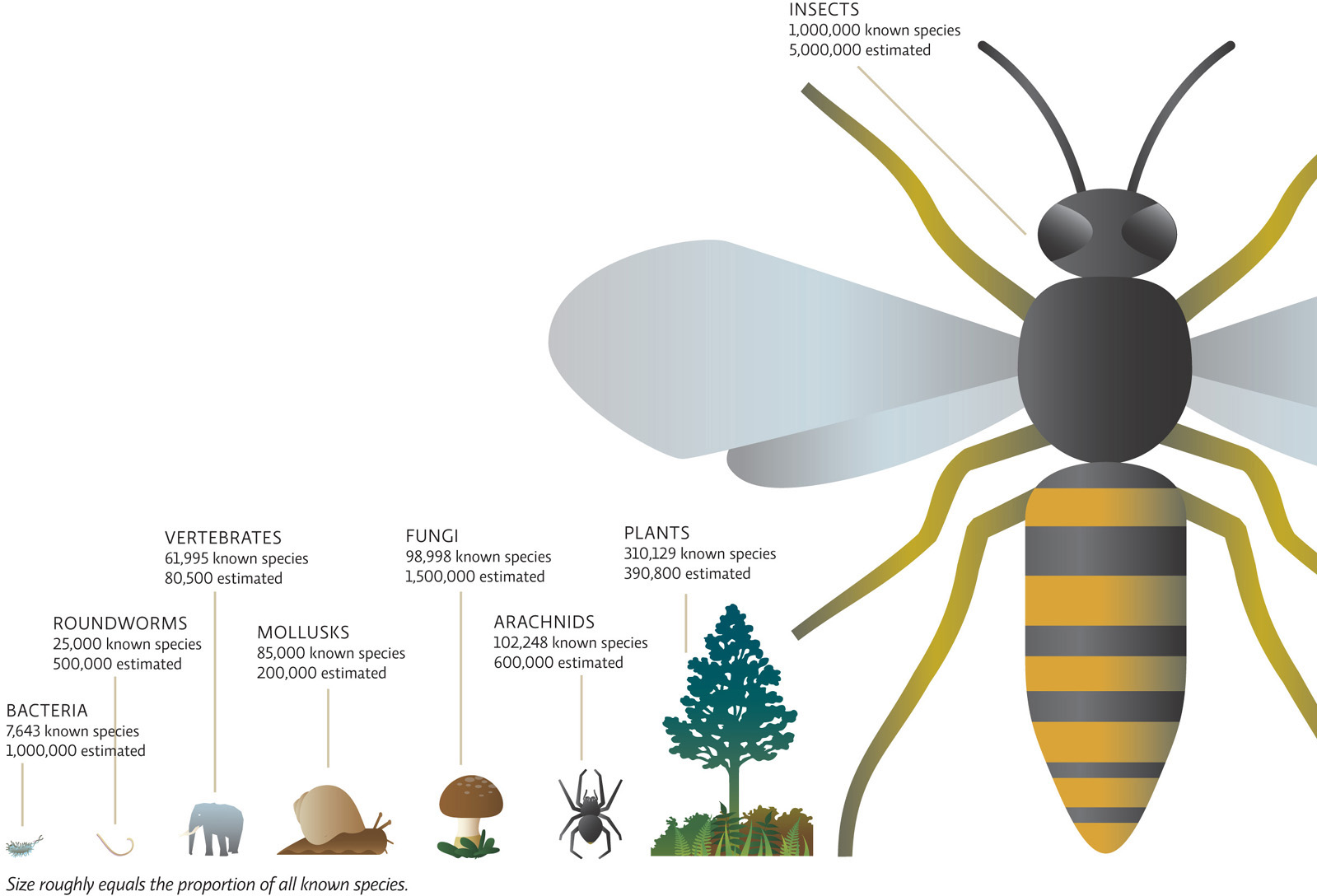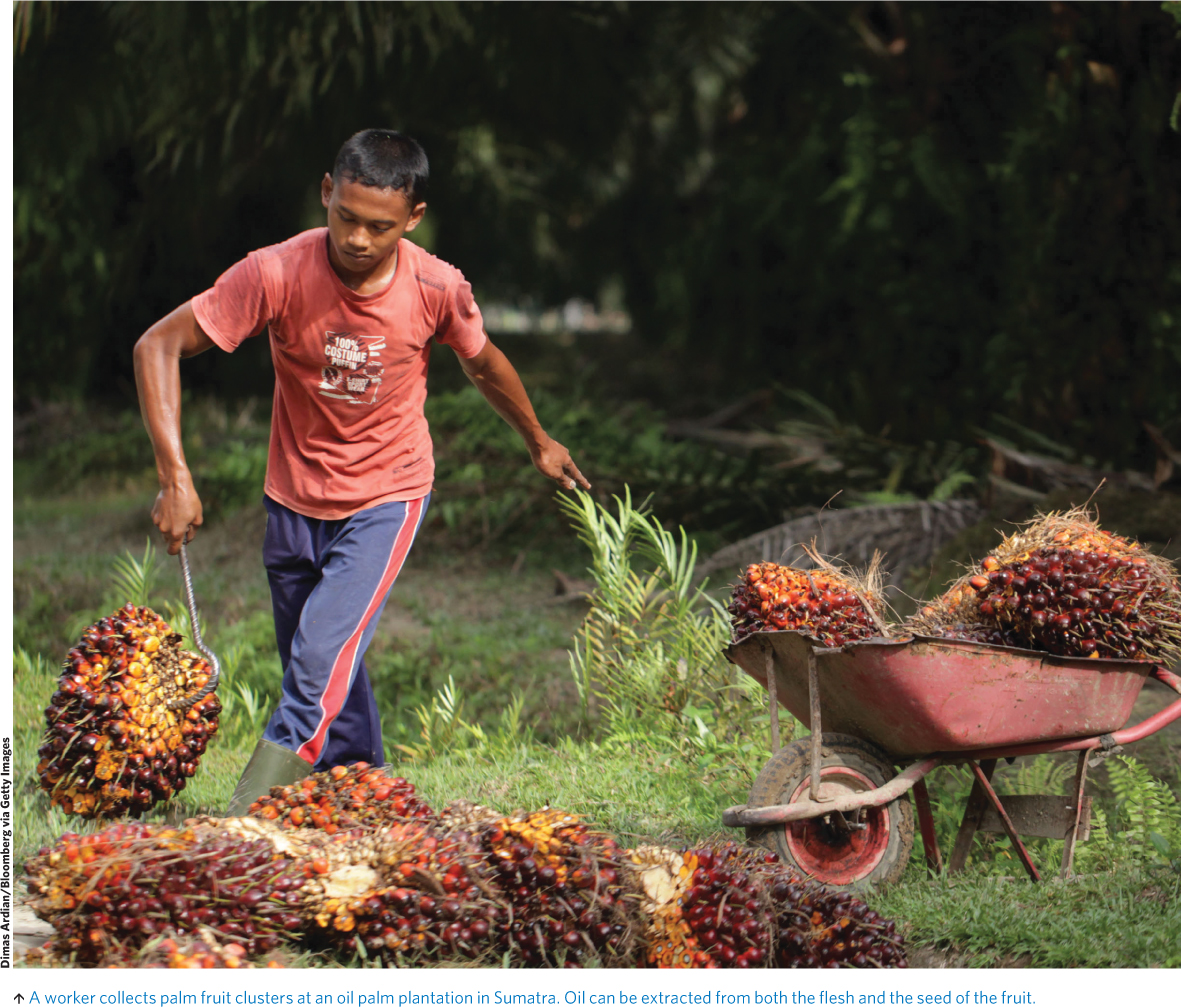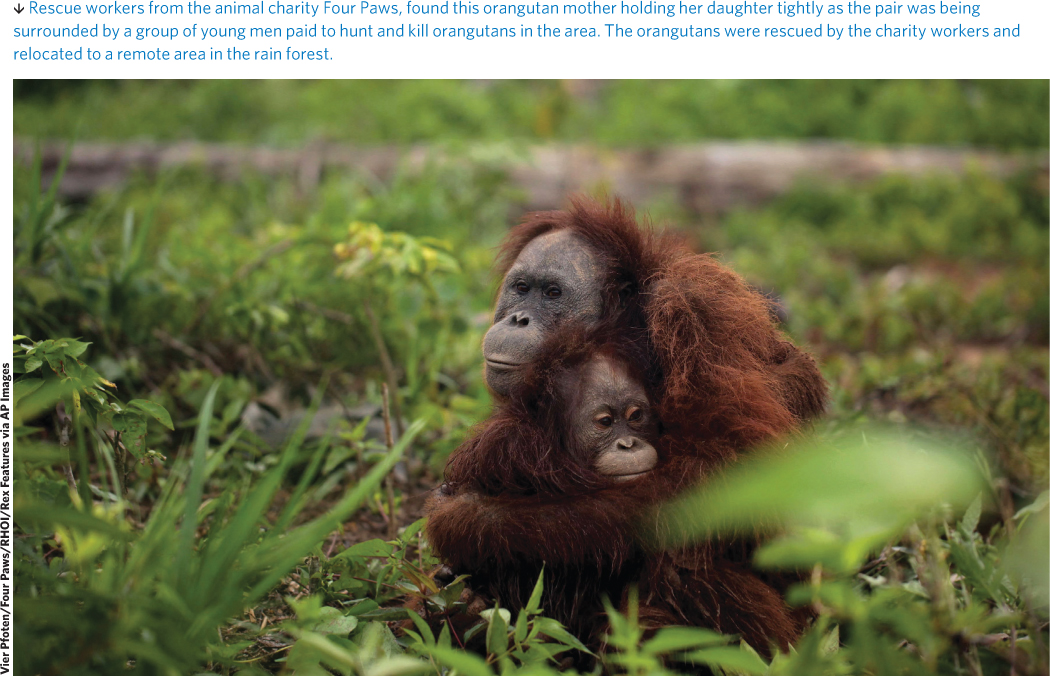Biodiversity provides a wide range of essential goods and services.
KEY CONCEPT 12.1
The variety of life (biodiversity) on Earth is tremendous, but we have identified only a fraction of the species that exist. Insects make up the largest group, but we know much more about smaller groups such as plants and vertebrates.
Rain forests, including those being cleared in Indonesia and Malaysia, contain the greatest concentration and variety of plant and animal terrestrial life-forms on Earth. This variety is called biodiversity, and it is the most unique and extraordinary feature of our planet. So great is the diversity of life on Earth that it is virtually impossible to know just how many species exist; in fact, many believe that the vast majority of all living species have yet to be discovered or identified by humans. So far science has identified about 1.9 million species, and common estimates for the total number of species on Earth range from 3 to 11 million (with one estimate as high as 100 million). Camillo Mora of Dalhousie University in Nova Scotia and colleagues estimate the total to be about 8.7 million. Most scientists agree that we have identified only a small fraction of the species that live on Earth. “The numbers are mind boggling,” says Jim Miller, a scientist at the Missouri Botanical Garden in St. Louis. “It’s almost unfathomable.” What we do know is that some life-forms are far more diverse than others; there are far more insects than there are vertebrates, for example, and there are relatively few mammals (fewer than 5,500 species) overall. INFOGRAPHIC 12.1
biodiversity
The variety of life on Earth; it includes species, genetic, and ecological diversity.
We have identified about 1.8 million species so far, but our knowledge of Earth’s total biodiversity is scant. Some researchers, especially those who work with tropical species and insects, believe the estimates of 3 to 11 million species are far too low; there may well be 5 million insect species alone. Of the species we have identified, insects far outnumber any other group of organisms. In fact, vertebrates (the group to which humans belong) likely make up only 1% of all creatures on Earth.


How important do you think it is it to get an accurate accounting of the number of species on Earth?
A good question to spark discussion in class. Answers will vary: knowing what lives in a given ecosystem gives us opportunities to use those species in whatever way might be beneficial (instrumental value); it could also help us protect ecosystems and reduce our own impact if we know what is there and what we might be disrupting with our actions; it is important to some people as part of an ongoing endeavor to chronicle nature for its own sake.

We also know that some regions of the world contain far greater concentrations of biodiversity—megadiversity—than other regions. Indonesia is one such region; it has more species of mammals, parrots, palms, swallowtail butterflies, and coral than any other country on the planet. Roughly 10% of all flowering plant species are found there. A recent census of a 3.4-square-kilometer (1.3-square-mile) plot on the Indonesian island of Siberut, for example, revealed 139 different species of trees. Indeed, tropical forests (and tropical coral reef ecosystems) are the most biodiverse in the world. John Terbough of the Duke University Center for Tropical Conservation reports that a 1-hectare (2.5-acre) research plot in an Amazonian rain forest contained close to 300 tree species. Compare this to the tree species diversity of the boreal forest that spans all of northern Canada—about 20 species.
Biodiversity is responsible for much more than the majesty of nature. For starters, it provides the key connections between individual species and between species and their environment. These connections help regulate the ecosystem as a whole: Insects pollinate flowers, for example. Photosynthetic organisms (plants on land, algae and phytoplankton in the sea) bring in energy, produce oxygen, and sequester carbon. Other organisms capture and pass along important nutrients like nitrogen and phosphorus. Others still help purify the air and water, and all species eventually become food for other creatures. Water also cycles through living things; in a forest, thousands of gallons a year are captured and passed along by each tree, releasing enough water vapor into the atmosphere to affect local rainfall. Life-giving soil forms as organisms decompose: Soil supports plant life whose roots, in turn, hold it in place, keeping it from being washed away in rains or floods. Meanwhile, predators and competitors keep each other in check, so that no single species grows too populous or gobbles up too many needed resources.
Biodiversity can also provide direct protection against disease in various ways. The incidence of Lyme disease, for example, is often lower in areas with higher biodiversity (especially areas with squirrels and possums, two species that effectively remove disease-carrying ticks and prevent the spread of the disease to other organisms). This is known as the dilution effect. Likewise, a study by John Swaddle of the University of California Santa Barbara and Stavros Calos of the College of William and Mary showed that fewer human cases of West Nile virus occur in eastern U.S. counties with higher bird biodiversity, possibly because some species are less effective at transmitting the virus than others—and the more species present, the less likely the virus will be transmitted to humans.
Biodiversity supplies cultural benefits as well—whether it is the enjoyment of a natural area for recreation or aesthetic appreciation, or a societal tradition rooted in nature.
Biodiverse ecosystems have economic value, too. Forests provide not only food, fuel, and building material but also pharmaceuticals. People use the chemicals they extract from plants and animals not only to attend to their individual human health but also as a source of income. Roughly half of all modern medicines—including medicine cabinet staples like aspirin and codeine, as well as most hypertension drugs and some cancer-fighting superstars—were originally derived from plants, many of them originally traditional remedies used for centuries. Over generations, rural forest-based communities in Sumatra have perfected a sophisticated management of forest resources that produces hillsides of coffee, elegant groves of cinnamon trees, acres of terraced rice paddies, forests of rubber trees, and a healthy mixture of fruit trees, vegetables, tobacco, and other useful edible, commercial, and medicinal plants.
KEY CONCEPT 12.2
Biodiversity contributes to the health and well-being of ecosystems, which in turn benefits human populations by providing ecosystem goods and services as well as cultural and health benefits.
Ever since Robert Costanza’s 1997 study that estimated the annual value of ecosystem services to be worth almost twice the annual gross domestic product of the entire world (close to $44 trillion in today’s dollars), ecological economists have set out to quantify the monetary worth of ecosystem services to bring attention to this often underappreciated value. Even nature-based recreation is a multibillion-dollar business worldwide. Whale watching, a pastime in more than 80 countries, brings in $1 billion annually. Visitors spent $12 billion at U.S. national parks in 2010. The U.S. Department of the Interior estimated the economic value of hunting, fishing, and wildlife viewing in 2001 to be $108 billion. (For more on valuing ecosystem services, see Chapter 6.) INFOGRAPHIC 12.2
ecosystem services
Essential ecological processes that make life on Earth possible.
We depend on genetically diverse, species-rich communities to provide the goods and services we use every day. Impoverished ecosystems that have lost genetic, species, or ecological diversity cannot perform these tasks as well as highly diverse ecosystems can.

Danita Delimont/Gallo Images/Getty

In terms of reasons to value biodiversity, which of the beneficial ecosystem services listed here are the most important to you personally? Which ones do you think might be the most influential to society?
Another good discussion question to reveal to students that their peers may feel very different about the value of biodiversity. Some will site cultural benefits as personally valuable while others may cite human provisions; still others may value ecosystem regulation and support and may connect that back to the other two categories. Society, however, may be most strongly affected by the benefit of human provisions (since it often operates for short term economic good) but students may argue different positions.

Of course, many people feel that the value of any given species goes beyond these instrumental values (i.e., the ecological, cultural, and economic benefits it brings). Many say that a species like the orangutan has intrinsic value (an inherent right to exist) and is therefore worth preserving, regardless of what benefits it might provide.
instrumental value
An object’s or species’ worth, based on its usefulness to humans.
intrinsic value
An object’s or species’ worth, based on its mere existence; it has an inherent right to exist.